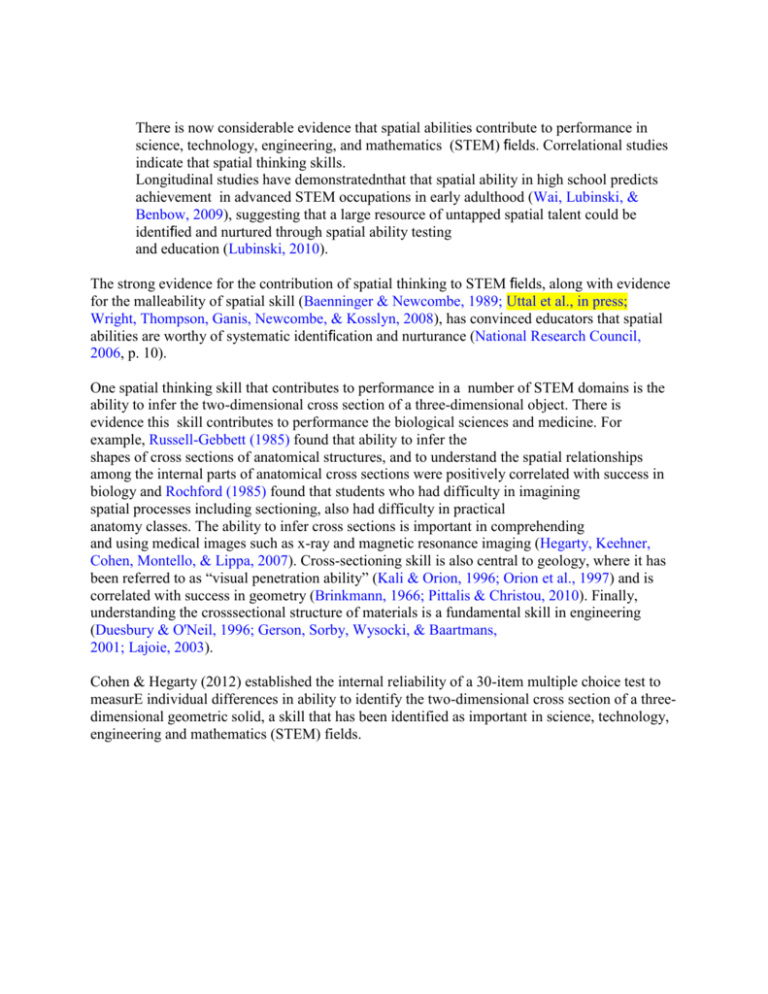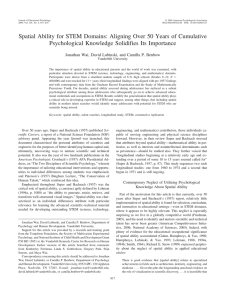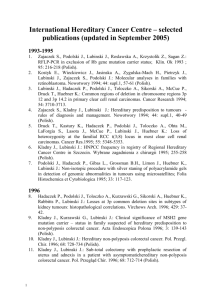There is now considerable evidence that spatial
advertisement

There is now considerable evidence that spatial abilities contribute to performance in science, technology, engineering, and mathematics (STEM) fields. Correlational studies indicate that spatial thinking skills. Longitudinal studies have demonstratednthat that spatial ability in high school predicts achievement in advanced STEM occupations in early adulthood (Wai, Lubinski, & Benbow, 2009), suggesting that a large resource of untapped spatial talent could be identified and nurtured through spatial ability testing and education (Lubinski, 2010). The strong evidence for the contribution of spatial thinking to STEM fields, along with evidence for the malleability of spatial skill (Baenninger & Newcombe, 1989; Uttal et al., in press; Wright, Thompson, Ganis, Newcombe, & Kosslyn, 2008), has convinced educators that spatial abilities are worthy of systematic identification and nurturance (National Research Council, 2006, p. 10). One spatial thinking skill that contributes to performance in a number of STEM domains is the ability to infer the two-dimensional cross section of a three-dimensional object. There is evidence this skill contributes to performance the biological sciences and medicine. For example, Russell-Gebbett (1985) found that ability to infer the shapes of cross sections of anatomical structures, and to understand the spatial relationships among the internal parts of anatomical cross sections were positively correlated with success in biology and Rochford (1985) found that students who had difficulty in imagining spatial processes including sectioning, also had difficulty in practical anatomy classes. The ability to infer cross sections is important in comprehending and using medical images such as x-ray and magnetic resonance imaging (Hegarty, Keehner, Cohen, Montello, & Lippa, 2007). Cross-sectioning skill is also central to geology, where it has been referred to as “visual penetration ability” (Kali & Orion, 1996; Orion et al., 1997) and is correlated with success in geometry (Brinkmann, 1966; Pittalis & Christou, 2010). Finally, understanding the crosssectional structure of materials is a fundamental skill in engineering (Duesbury & O'Neil, 1996; Gerson, Sorby, Wysocki, & Baartmans, 2001; Lajoie, 2003). Cohen & Hegarty (2012) established the internal reliability of a 30-item multiple choice test to measurE individual differences in ability to identify the two-dimensional cross section of a threedimensional geometric solid, a skill that has been identified as important in science, technology, engineering and mathematics (STEM) fields. The goal of this study is to establish the validity of the Santa Barbara Solids Test in predicting performance in geology tasks that require this ability.








